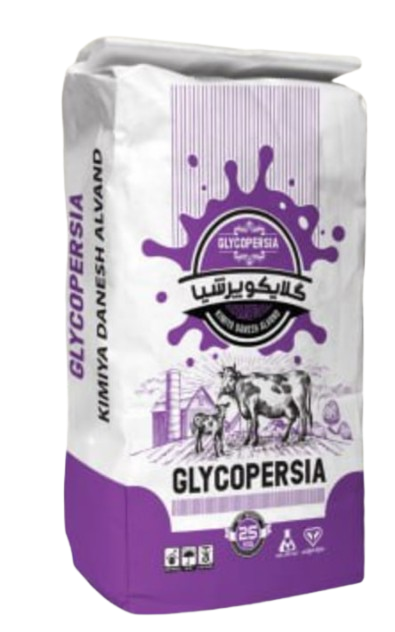Our company provides a comprehensive range of products, including capsules, boluses, pastes, soluble powders, specialized electrolytes for calves and cows, and daily feed additives.


Improves immune function
Supports maximum milk production
Increases dry matter intake
Treats ketosis
Reduces clinical and subclinical ketosis and reduces depletion of body stores
Reduces inflammation
Sometimes, cows experience increased milk production and subsequent nutrient requirements during lactation. In the meantime, the reduction in dry matter intake by cows is a major challenge in meeting these needs. Reduced nutrient intake increases the conversion of body resources into materials needed for milk production and increases the likelihood of diseases such as clinical and subclinical ketosis by 15 to 40 percent.
Clinical and subclinical ketosis are common metabolic disorders in early lactation, which are especially common in scenarios of inefficient management and low energy levels in cow feed. These disorders can lead to reduced milk production, reduced economic efficiency of the herd and increased likelihood of secondary diseases.
Glucose supplementation in the rumen can help reduce these problems. This supplement is designed with an optimal combination of specific raw materials and a continuous release of glucogens in the rumen to provide the necessary energy for lactating cows. The combination of this supplement with high glucose and its gradual release in the rumen allows cows to meet their energy needs during the early lactation period and prevent problems such as ketosis.
| Nutrient | Increase in Requirement |
|---|---|
| Glucose | 2.7 times that of a pregnant uterus |
| Amino acids | 2 times that of a pregnant uterus |
| Fatty acids | 4.5 times that of a pregnant uterus |
| Total energy requirement | 3 times that of a pregnant uterus |
Another feature of the diets for the postpartum period, based on recent research, is not to increase the amount of concentrate too much and to consume diets with a higher proportion of forage in order to maintain rumen protection and thus prevent abnormalities such as acidosis, lameness and displacement of the abomasum, which affect the ability to produce the required energy and glucose. This is while groups with the ability to rapidly ferment starch, while reducing rumen pH and increasing the risk of acidosis, the amount of harmful and toxic metabolites of volatile proteins such as methylglyoxal and serum malondialdehyde, and subsequently increasing the risk of inflammation and oxidative stress.
Consumption of gluconeogenic compounds with an optimal combination such as glucose and gluconate during this period reduces post-partum disorders such as ketosis, impaired reproductive efficiency and increased elimination, and also allows the provision of the necessary energy from glucose sources and removes pressure from body fat.
In addition, the use of glucose precursors in the rumen for glucose and milk fat synthesis by reducing NADPH production (from the other pathway) and by reducing serum free fatty acids (NEFA) levels rapidly reduces metabolic failure without the need for rapid oxidative energy supply from body stores.
In addition, this combination, by preserving milk fat in general, controls the cow’s body production and reduces the burden on the liver. Ultimately, this combination reduces the signs of ketosis and regulates the metabolic production of energy to the body. Energy regulation to meet the high production needs during early lactation in a way that does not exacerbate ketosis for the calf or for the body itself.
Glycorpichia is produced on an organic carrier substrate.
Glycorpichi contains an optimal ratio of effective ingredients to maximize the glucose production capacity of the liver.
Glycorpichia prevents the loss of dry matter consumed with an optimal ratio of precursor ingredients and the use of innovative ingredients.
The degradation of the precursor used in Glycorpichia enters the glucose production cycle through various pathways and mechanisms.
Glycorpichia reduces the amount of methane produced in the rumen and increases the ratio of propionate consumption to volatile fatty acids.
Improved energy supply from the active ingredient is among the glucose precursor products on the market.
Glycorpichia has a rapid effect on the body and is continuously released in the rumen.
The specific ingredients in Glycorpichia reduce the withdrawal from body reserves.
Glycorpichia does not cause a drop in rumen pH and acidosis.
Glycoripchia contains an optimal ratio of glycerol, monopropionate, glycogol and Krebs cycle intermediates reconstituted on a corn pellet substrate with sustained release capability in the rumen. Each of the active compounds in the structure of Glycoripchia provides glucose precursors in the liver for use in gluconeogenesis production through different mechanisms. In addition to these, Glycoripchia compounds are capable of modulating body reserves and reducing serum free fatty acids, improving blood energy balance and improving the defense system, reducing the accumulation of oxidative substances and harmful metabolites in the liver, and reducing some unstable conditions for the gluconeogenesis pathway. The ratio of B12 nitrogen to protein in this compound is adjusted in such a way that it provides better conditions for energy production and metabolism.
Due to the presence of the other two phosphate synthases (NADPH precursors through the production of cellulase, sterols) and glucose in propionate, and the increase in active substances on these two pathways, Glycoripchia provides a balance of energy, vitality and greater efficiency.
The effective composition of Glycoripchia provides rapid and continuous energy for production and prevents rapid depletion of body reserves. This composition has a significant ability to meet the high energy needs of newborn cows, cows in early calving and ewes in heat with twins and multiples, and prevents the occurrence of toxicity caused by ketosis.
Cows and heifers ready to calve (300-400 grams per day)
Newly calved cows (300-500 grams per day)
High-producing cows (150-200 grams per day)
High-producing cows during heat stress (300-400 grams per day)
Ewes and goats pregnant with twins and triplets (50-100 grams per day)
Our company provides a comprehensive range of products, including capsules, boluses, pastes, soluble powders, specialized electrolytes for calves and cows, and daily feed additives.